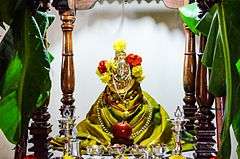Varalakshmi Vratam
VaramahalakshmiVrata (ಶ್ರೀ ವರಮಹಾಲಕ್ಷ್ಮೀ ವ್ರತ) is a festival to propitiate the Goddess Lakshmi. Varalakshmi is one who grants boons ("Vara"). It is an important pooja performed by many women in the states of Karnataka, Andhra Pradesh, Telangana, Tamil Nadu, Maharastra and Uttar Pradesh. The Hindu festival going by the name 'Vara MahaLakshmi Vrata' is celebrated on the Second Friday or the Friday before the day of the full moon - Poornima - in the month of Shravana, which corresponds to the Gregorian months of July–August.
| VaralakshmiVrata | |
|---|---|
 A typical view of the Varalakshmi Vrata Pooja | |
| Official name | Varalakshmi Vrata |
| Observed by | All South Indian states |
| Type | Pooja |
| Significance | Religious |
| 2019 date | 9 August 2019[1] |
| Frequency | Annual |
Varamahalakshmi Vrata is performed by women for their own well being and that of all their family members. It is believed that worshipping the Goddess Varalakshmi on this day is equivalent to worshipping Ashtalakshmi – the eight goddesses of Wealth, Earth, Wisdom, Love, Fame, Peace, Contentment, and Strength. Due to the rising popularity of this holy day in some states, it is now being declared as an optional official holiday in India.
The 2020 date is 31 July Friday.
History
In the Magadha of yore, there lived a woman called Charumathi in a town named Kundinyapura (now in Amravati district in Maharashtra). Impressed of her devotion to the goddess, the Goddess Mahalakshmi appeared in her dream and asked her to worship Varalakshmi (Vara = boon, Lakshmi = goddess of wealth) and seek to fulfill her wishes. Varalakshmi is yet another form of Lakshmi, the goddess of wealth. The prayer/worship was prescribed to be offered on the Friday of Shravana month preceding the night of the full moon.
When Charumathi explained her dream to her family, they encouraged her to perform the pooja. Many other women of the village joined her in performing the pooja in a traditional way and offered many sweets to the Goddess Varalakshmi, along with sacred chants.
| Sanskrit | English alphabet transliteration | English translation |
|---|---|---|
| पद्मसने पद्मकरे | Padmaasane Padmakare | (She) who sits in the lotus, (she) who holds the lotus ("Lotus-sitter, Lotus-holder") |
| सर्व लोकैक पूजिते। | sarva lokaika poojithe | (She) to whom all the worlds pray |
| नारायणप्रिये देवि | Narayanapriya devi | Goddess who is dear to Narayana |
| सुप्रीता भव सर्वदा॥ | supreethaa bhava sarvada | be kind/good to me |
l
Ceremony
On this occasion, women worship Goddess Lakshmi with utmost devotion offering fruits, sweets and flowers, usually a kalasam (representing the deity) will be decorated with a saree, flowers and gold jewelry with offerings placed in front.[2]
A rakshai/saradu (sacred thread) is among the offerings and adorned on the wrists of women after the pooja has been completed. This is worn to signify protection and piety, and several articles are given as gifts and charity in good faith. This pooja can be performed with no restriction to caste or creed. To this day, many women observe this traditional festival praying to Varamahalakshmi for her blessings in the form of wealth and well being of their family.
Elaborate Varalakshmi Vrata puja packs have now been made available for the modern families by various suppliers now. [3]
Significance
Eight forces or energies are recognised and they are known as Siri (Wealth), Bhu (Earth), Sarasvathi (Wisdom), Preethi (Love), Keerthi (Fame), Shanthi (Peace), Santhushti (contentment) and Pushti (Strength). Each one of these forces is called a 'Lakshmi' aka:
- Aadi Lakshmi (the Protector)
- Dhana Lakshmi (Goddess of Wealth)
- Dhairya Lakshmi (Goddess of Courage)
- Sowbhagya Lakshmi (Goddess of Prosperity)
- Vijaya Lakshmi (Goddess of Victory)
- Dhanya Lakshmi (Goddess of Nourishment)
- Santaana Lakshmi (Goddess of Progeny)
- Vidhya Lakshmi (Goddess of Wisdom)
All the eight forces combined are called the Ashta Lakshmis or the eight Lakshmis of the Hindus.
Vishnu is also called 'Ashtalakshmi Pathi' which is equivalent to saying that he is the consort for the eight Lakshmis or forces. In fact, Vishnu representing the preservative aspect of the universe, radiates these feminine energies of Lakshmi personified and worshipped as such since abstract force is beyond the comprehension of the ordinary people. As health, wealth and prosperity depend upon the rhythmic play of these forces, the worship of Lakshmi is said to obtain these three. This festival is observed largely by women, invoking the blessings of the goddess Lakshmi.
Legend
As the legend goes, this is a pooja that was performed by the goddess Parvathi to seek prosperity and happiness. Thus it came to be emulated by women who sought boons (varam) for the health, wealth and knowledge for the entire family. The prescribed day for the pooja is the Friday of the month of Sravan in the fortnight known as Sukla paksha, preceding the full moon day.
Gallery
- View of an actual religious ceremony
Popular culture
References
- "On Varlakshmi Vrat, do this puja, so every wish will be fulfilled". News Track. Retrieved 8 August 2019.
- http://divineavatars.com/festivals/vara-lakshmi-vrata.html
- Sampoorna Varamahalakshmi Puja Kit